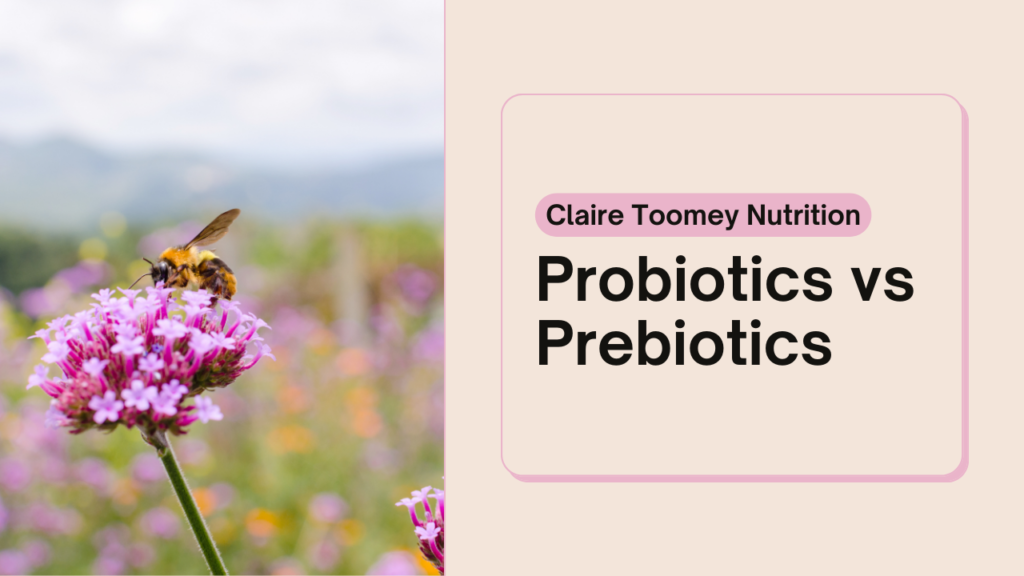Probiotics vs Prebiotics: What’s the Difference?
Do you find yourself using the terms probiotics and prebiotics interchangeably, without really knowing what they mean? You’re probably aware that both are great for gut health and overall wellness, but the difference can sometimes feel unclear. Here’s a simple breakdown:
- Probiotics add beneficial bacteria and yeasts to your body (e.g., kefir, kombucha, live yoghurt, kefir).
- Prebiotics feed the beneficial bacteria (e.g., foods high in plant fibres like chicory root, asparagus, or Jerusalem artichokes).
Simply put, prebiotics feed probiotics. Think of your microbiome as a beautiful ecosystem: probiotics are like the bees that help the environment thrive, while prebiotics are the flowers feeding those bees, keeping them alive and buzzing.
Let’s dig a little deeper…
Probiotics 🐝
Probiotics are live microorganisms (bacteria and yeast) that, when consumed in sufficient amounts, provide health benefits to the host (that’s you!).
For optimal gut health, diversity is key! To increase bacterial diversity in your gut, it’s helpful to consume a probiotic source with multiple strains. The more diverse your probiotic, the more it supports overall gut diversity.
Some man-made probiotics contain only a few strains, which can limit their effectiveness. On the other hand, traditionally fermented foods like kefir, live yogurt, kimchi, sauerkraut, kombucha, and miso can offer a wide array of naturally occurring bacterial strains. Real, fermented kefir, for example, contains a unique community of beneficial bacteria that grow together over time, providing a potent and increasing probiotic effect compared to powdered or lab-created probiotics, which often lose strength over their shelf life.
To boost your bacterial diversity, try incorporating a variety of naturally fermented foods into your diet. These foods add beneficial, live cultures to your gut, helping to create a robust and diverse ecosystem.
Prebiotics 🌸
There are an estimated five nonillion microbes on our planet (that’s a 5 with 30 zeroes!) – and those microbes need fuel! Prebiotics are non-living, indigestible plant fibres that act as food for the beneficial bacteria in your gut.
Prebiotics can powerfully influence human health, offering benefits that support immune function, blood sugar regulation, inflammation reduction, and even cardiovascular health. Prebiotics can also be effective against certain digestive issues, metabolic imbalances, obesity, and mental health challenges.
Because they’re highly stable, prebiotic supplements make it easy to add fibre diversity to your diet, reaching your gut intact as they are unaffected by acidity or heat. High-quality prebiotic blends often combine various natural fibres to maximize benefits in one serving.
However, many prebiotic fibres are already found in common plant foods, including asparagus, green bananas, Jerusalem artichokes, garlic, leeks, onions, barley, rye, oats, soybean, chicory root, lentils, potatoes, and peas. Getting a variety of these foods can naturally fuel your beneficial gut bacteria.
Put them together and you get… Synbiotics.
Probiotic + Prebiotic = Synbiotic
A synbiotic is simply a combination of a probiotic and a prebiotic, promoting a range of health benefits by enhancing the effectiveness of probiotics in the gut.
Synbiotics have been linked to improved gut health, enhanced immune function, reduced inflammation, and even mental health support. Combining a high-quality probiotic (like live kefir or yoghurt) with prebiotic-rich foods or supplements can offer a potent boost of nutrients and bacterial support, promoting a healthy, balanced gut ecosystem.
Bringing It Home: Bees and Flowers
To land this concept, just think of bees and flowers: probiotics are like the bees—living organisms that bring many benefits to your internal ecosystem. Prebiotics are the flowers that feed these bees, keeping them strong and able to thrive. Together (as a synbiotic), they create a vibrant, healthy ecosystem where beneficial growth can flourish.
Have questions or looking for support on your gut health journey? Get in touch – I’m here to help!


Pingback: Gut-Nourishing Prebiotic Soup - Claire Toomey Nutrition
Pingback: Banana Buckwheat Pancakes - Claire Toomey Nutrition
Pingback: White Chocolate Pistachio Pancakes - Claire Toomey Nutrition